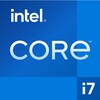Intel Core i7-1280P
Intel Core i7-1280P

The Intel Core i7-1280P is the flagship Alder Lake-P CPU, which is to say, an expensive 28 W part meant for use in ultra-light (yet actively cooled) laptops. This CPU was announced in early 2022 and it has 6 performance cores (P-cores, Golden Cove architecture) mated to 8 efficient cores (E-cores, Gracemont architecture). The P-cores are Hyper-Threading-enabled for whopping 20 threads when combined with the E-cores. The clock speeds range from 1.8 GHz to 4.8 GHz for the performance cluster and 1.3 GHz to 3.6 GHz for the efficiency cluster. This is the only hexa-core 28 W Alder Lake CPU as of February 2022, trumping what the more affordable i7-1270P and i7-1260P have in store. Full vPro feature set is supported by this Core i7 ("Enterprise" tier, allowing for remote device management).
Architecture
The i7 is a continuation of Intel's efforts to use the ARM-developed big.LITTLE technology for its own benefit. A single "little" Alder Lake core is supposed to be just as fast as a Skylake core (as found in the venerable Core i7-6700HQ among other options) which is six years old at this point. All of a Core i7-1280P's CPU cores enjoy access to 24 MB of L3 cache. The integrated memory controller supports up to 64 GB of LPDDR5-5200, DDR5-4800, LPDDR4x-4267 or DDR4-3200 RAM. Just like the other 12th Gen Intel Core processors, Core i7-1280P comes with Thread Director which is a new functionality designed to help Windows 11 decide which cores to use for what workload for best performance and efficiency possible. Hardware acceleration of AI algorithms is supported via GNA 3.0 and DL Boost (via AVX2). PCI-Express 5.0 support has not found its way into Alder Lake P processors, so users will have to be content with PCI-Express 4.0 for the time being. Four PCI-Express 4 lanes allow for a read/write rate of up to 7.9 GB/s, provided a suitably fast NVMe SSD is used.
Please note this is not a user-replaceable CPU. It gets soldered permanently on to the motherboard (BGA1744 socket interface).
Performance
Provided the long-term Power Limit is set to a decently high value (> 30 W) and the cooling solution is a good one, the 14 CPU cores will easily outshine any laptop-grade hexa-core Tiger Lake processor (Core i7-11600H included) while also beating any U-class Ryzen 5000 / Ryzen 6000 option. A well-cooled i7-1280P would have all it takes to be trading blows with the i7-11800H, a higher-wattage CPU marketed towards gamers and digital artists.
Performance-per-thread figures of Alder Lake P chips are indeed impressive but this comes at a cost. CPU package power can be disturbingly close to 30 watts when just a single P-core is heavily loaded.
Graphics
The built-in graphics adapter in the form of the 96 EU Iris Xe running at up to 1.45 GHz has seen no change from what was built into the 11th Gen Tiger Lake-UP3 processors, like a i7-1165G7, which is hardly a downside as this iGPU is loaded with modern features such as AV1 video decoding capability and SUHD 4320p monitor support. An Iris Xe Graphics G7 will let you use up to 4 monitors simultaneously, provided the laptop has the ports required.
The graphics adapter will let you play most games at 1080p / Medium settings to be very close to NVIDIA's MX350. AMD's 680M as found in certain Ryzen 6000 chips is slated to be noticeably faster than the 96 EU Iris Xe, though.
That being said, the Xe's gaming performance is bound to be tied to how high the Power Limits and how competent the cooling solution of a laptop are. Fast RAM is a prerequisite for decent performance as well (the Iris Xe has to make do with no dedicated video memory).
Last but not the least, we discovered that the GPU utilization when playing YouTube UHD 2160p60 videos is higher than it was with Tiger Lake chips.
Power Consumption
The i7's base power (also known as the default TDP value or PL1) is 28 W with 64 W being its Intel-recommended Turbo power (also known as PL2). Core i7-1280P is manufactured on Intel's third-gen 10 nm process marketed as Intel 7 for an OK energy efficiency - on paper, that is. The tests we did proved that Intel's way to close the performance gap with AMD's Ryzen 5000 processors entails some seriously high power consumption figures where a single P-core's consumption ca be north of 20 W. AMD's Ryzen 5000 chips are not nearly as power-hungry, and Apple's M1-series processors can be several times more efficient while upholding a similarly high performance bar.
| Series | Intel Alder Lake-P | ||||||||||||||||||||||||||||||||||||||||||||||||||||
| Codename | Alder Lake-P | ||||||||||||||||||||||||||||||||||||||||||||||||||||
| Series: Alder Lake-P Alder Lake-P |
| ||||||||||||||||||||||||||||||||||||||||||||||||||||
| Clock Rate | 1300 - 4800 MHz | ||||||||||||||||||||||||||||||||||||||||||||||||||||
| Level 1 Cache | 1.2 MB | ||||||||||||||||||||||||||||||||||||||||||||||||||||
| Level 2 Cache | 23.5 MB | ||||||||||||||||||||||||||||||||||||||||||||||||||||
| Level 3 Cache | 24 MB | ||||||||||||||||||||||||||||||||||||||||||||||||||||
| Number of Cores / Threads | 14 / 20 | ||||||||||||||||||||||||||||||||||||||||||||||||||||
| Power Consumption (TDP = Thermal Design Power) | 28 Watt | ||||||||||||||||||||||||||||||||||||||||||||||||||||
| Manufacturing Technology | 10 nm | ||||||||||||||||||||||||||||||||||||||||||||||||||||
| Max. Temperature | 100 °C | ||||||||||||||||||||||||||||||||||||||||||||||||||||
| Socket | FCBGA1744 | ||||||||||||||||||||||||||||||||||||||||||||||||||||
| Features | Thread Director | ||||||||||||||||||||||||||||||||||||||||||||||||||||
| GPU | Intel Iris Xe Graphics G7 96EUs ( - 1450 MHz) | ||||||||||||||||||||||||||||||||||||||||||||||||||||
| 64 Bit | 64 Bit support | ||||||||||||||||||||||||||||||||||||||||||||||||||||
| Architecture | x86 | ||||||||||||||||||||||||||||||||||||||||||||||||||||
| Announcement Date | 01/04/2022 = 156 days old | ||||||||||||||||||||||||||||||||||||||||||||||||||||
| Product Link (external) | Intel Alder Lake-P i7-1280P |
Benchmarks
* Smaller numbers mean a higher performance
Comments
Post a Comment